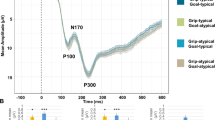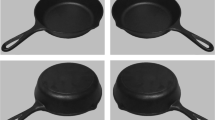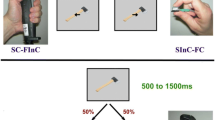Abstract
We carried out a study examining the electrophysiological responses when participants made object decisions to objects and non-objects subject to congruent and incongruent hand-grip actions. Despite the grip responses being irrelevant to the task, event-related potentials were sensitive to the handgrip. There were effects of grip congruency on both P1 and N1 components, over both posterior and motor cortices, with the effects emerging most strongly for familiar objects. In addition, enhanced lateralized readiness potentials were observed for incongruent grips. The results suggest that there are increased perceptual and motor-based responses to objects and object-like stimuli that are grasped correctly, even when the grip is irrelevant to the task. This is consistent with the automatic coding of potential appropriate actions based on visual information from objects in the environment.





Similar content being viewed by others
Notes
Note that, as the sink for perceptual P1 and N1 components, the effects over motor cortex showed an inverse waveform, with the P1 being negative in direction and the N1 positive.
References
Aron AR, Fletcher PC, Bullmore ET, Sahakian BJ, Robbins TW (2003) Stop-signal inhibition disrupted by damage to right inferior frontal gyrus in humans. Nat Neurosci 6:115–116
Bender S, Becker D, Oelkers R, Weisbord M (2006) Cortical motor areas are activated early in a characteristic sequence during post movement processing. Neuroimage 32:333–351
Borghi AM, Bonfiglioli C, Ricciarelli P, Rubichi S, Nicoletti R (2005) Visual hand primes and manipulable objects. In: Bara B, Barsalou L, Bucciarelli B (eds) COGSCI2005. XXVII annual conference of the cognitive science society, Lawrence Erlbaum Associates Inc, Mahwah NJ, pp 322–327
Borghi AM, Bonfiglioli C, Lugli L, Ricciardelli P, Rubichi S, Nicoletti R (2007) Are visual stimuli sufficient to evoke motor information? Studies with hand primes. Neurosci Lett 411:17–21
Boulenger V, Silber BY, Roy AC, Paulignan Y, Jeannerod M, Nazir TA (2008) Subliminal display of action words interferes with motor planning: a combined EEG and kinematic study. J Physiol-Paris 102:130–136
Chambers CD, Bellgrove MA, Gould IC, English T, Garavan H, McNaught E, Kamke M, Mattingley JB (2007) Dissociable mechanisms of cognitive control in prefrontal and premotor cortex. J Neurophysiol 98:3638–3647
Creem-Regehr SH, Lee JN (2005) Neural representations of graspable objects: are tool special? Cogn Brain Res 22:457–469
Decety J, Perani D, Jeannerod M, Bettinardi V, Tadary B, Woods R, Mazziotta JC, Fazio F (1994) Mapping motor representations with positron emission tomography. Nature 371:600–602
Faillenot I, Toni I, Decety J, Gre′goire MC, Jeannerod M (1997) Visual pathways for object-oriented action and object recognition: functional anatomy with PET. Cereb Cortex 7:77–85
Fogassi L, Gallese V, Buccino G, Craighero L, Fadiga L, Rizzolatti G (2001) Cortical mechanism for the visual guidance of hand grasping movements in the monkey: a reversible inactivation study. Brain 124:571–586
Gibson JJ (1979) The ecological approach to visual perception. Houghton Mifflin, Boston
Girardi G, Lindemann O, Bekkering H (2010) Context effects on the processing of action-relevant object features. J Exp Psychol Hum Percept Perform 36:330–340
Grafton ST, Arbib MA, Fadiga L, Rizzolatti G (1996) Localization of grasp representations in humans by positron emission tomography 2. Observation compared with imagination. Exp Brain Res 112:103–111
Gratton G, Coles MGH, Donchin E (1983) A new method for the off-line removal of ocular artifact. Electroencephalogra Clin Neurophysiol 55:468–484
Grezes J, Decety J (2002) Does visual perception of object afford action? Evidence from a neuroimaging study. Neuropsychologia 40:212–222
Grezes J, ArmonyJL RoweJ, Passingham RE (2003) Activations related to “mirror” and “canonical” neurons in the human brain: an fMRI study. NeuroImage 18:928–937
Guthrie D, Buchwald JS (1991) Significance testing of difference potentials. Psychophysiol 28:240–244
Handy TC, Grafton ST, Shroff NM, Ketay S, Gazzaniga MS (2003) Graspable objects grab attention when the potential for action is recognized. Nat Neurosci 6:421–427
Handy TC, Tipper CM, Schaich Borg J, Grafton ST, Gazzaniga MS (2006) Motor experience with graspable objects reduces their implicit analysis in visual and motor-related cortex. Brain Res 1097:156–166
Helbig HB, Graf M, Kiefer M (2006) The role of action representations in visual object recognition. Exp Brain Res 174:221–228
Helbig HB, Steinwender J, Graf M, Kiefer M (2010) Action observation can prime visual object recognition. Exp Brain Res 200:251–258
Hoenig K, Sim EJ, Bochev V, Herrnberger B, Kiefer M (2008) Conceptual flexibility in the human brain: dynamic recruitment of semantic maps from visual, motor, and motion-related areas. J Cogn Neurosci 20:1799–1814
Holm S (1979) A simple sequential rejective multiple test procedure. Scand J Stat 6:65–70
Humphreys GW, Riddoch MJ (2007) How to define an object: evidence from the effects of action on perception and attention. Mind Lang 22:534–547
Ilan AB, Miller J (1999) A distinction between the initiation and the continuation of response preparation. Psychophysiology 36:209–219
Jentzsch I, Sommer W (2001) Sequence-sensitive subcomponents of P300: topographical analyses and dipole source localization. Psychophysiology 38:607–621
Johnson-Frey SH, Maloof FR, Newman-Norlund R, Farrer C, Inati S, Grafton ST (2003) Actions or hand-object interactions? Human inferior frontal cortex and action observation. Neuron 39:1053–1058
Johnson-Frey SH, Newman-Norlund R, Grafton ST (2005) A distributed left hemisphere network active during planning of everyday tool use skills. Cereb Cortex 15:681–695
Kiefer M, Sim EJ, Liebich S, Hauk O, Tanaka J (2007) Experience-dependent plasticity of conceptual representations in human sensory-motor areas. J Cogn Neurosci 19:525–542
Kiefer M, Sim EJ, Helbig H, Graf M (2011) Tracking the time course of action priming on object recognition: evidence for fast and slow influences of action on perception. J Cogn Neurosci 23:1864–1874
Leonardo M, Fieldman J, Sadato N, Campbell G, Ibanez V, Cohen L, Deiber M, Jezzard P, Pons T, Turner R, Le Bihan D, Hallet M (1995) A functional magnetic resonance imaging study of cortical regions associated with motor task execution and motor ideation in humans. Hum Brain Mapp 3:83–92
Leuthold H, Sommer W, Ulrich R (2004) Preparing for action: inferences from CNV and LRP. J Psychophysiol 18:77–88
Masaki H, Wild-Wall N, Sangals J, Sommer W (2004) The functional locus of the lateralized readiness potential. Psychophysiology 41:220–230
Oostenveld R, Praamstra P (2001) The five percent electrode system for high resolution EEG and ERP measurements. Clin Neurophysiol 11:713–719
Petit LS, Pegna AJ, Harris IM, Michel CM (2006) Automatic motor cortex activation for natural as compared to awkward grips of manipulable object. Exp Brain Res 168:120–130
Rizzolatti G, Fadiga L, Matelli M, Bettinardi V, Paulesu E, Perani D, Fazio F (1996) Localization of grasp representations in humans by PET: 1. Observation versus execution. Exp Brain Res 111:246–252
Roberts KL, Humphreys GW (2010) Action relationships concatenate representations of separate objects in the ventral visual system. NeuroImage 52:1541–1548
Rohrbaugh JW, Donchin E, Ericksen CW (1974) Decision making and P300 component of the cortical evoked response. Percept Psychophys 15:368–374
Roth M, Decety J, Raybaudi M, Massarelli R, Delon-Martin C, Segebarth C, Morand S, Gemignani A, Decorps M, Jeannrod M (1996) Possible involvement of primary motor cortex in mentally simulated movement: a functional magnetic resonance imaging study. NeuroReport 7:1280–1284
Salisbury DF, Griggs CB, Shenton ME, McCarley RW (2004) The NoGo P300 ‘anteriorization’ effect and response inhibition. Clin Neurophysiol 115:1550–1557
Scherg M (1990) Fundamentals of dipole source potential analysis. In: Grandori F, Hoke M, Romani GL (eds) Auditory evoked magnetic fields and electric potentials. Advances in audiology, vol 6. Karger, Basel, pp 40–46
Schmitt BM, Munte TF, Kutas M (2000) Electrophysiological estimates of time course of semantic and phonological encoding during implicit picture naming. Psychophysiology 37:473–484
Schutz-Bosbach S, Prinz W (2007) Perceptual resonance: action-induced modulation of perception. Trends Cogn Sci 11:349–355
Smith D, Donchin E, Cohen L, Starr A (1970) Auditory evoked potentials in man during selective binaural listening. Electroencephalogr Clin Neurophysiol 78:146–152
Stephan KM, Fink GR, Passingham RE, Silbersweig D, Ceballos-Baumann AO, Frith CD, Frackowiak RS (1995) Functional anatomy of the mental representation of upper extremity movements in healthy subjects. J Neurophysiol 73:373–386
Symes Ed, Tucker M, Ellis R, Vainio L, Ottoboni G (2008) Grasp preparation improves change detection for congruent objects. J Exp Psychol Hum Percept Perform 34:854–871
Tucker M, Ellis R (1998) On the relations between seen objects and components of potential actions. J Exp Psychol Hum Percept Perform 24:830–846
Tucker M, Ellis R (2001) The potentiation of grasp types during visual object categorization. Vis Cogn 8:769–800
Vainio L, Symesa E, Ellisa R, Tuckera M, Ottoboni G (2008) On the relations between action planning, object identification, and motor representations of observed actions and objects. Cognition 108:444–465
van Schie HT, Mars RB, Coles MG, Bekkering H (2004) Modulation of activity in medial frontal and motor cortices during error observation. Nat Neurosci 7:549–554
Yoon EY, Humphreys GW (2005) Direct and indirect effects of action on object classification. Mem Cognit 33:1131–1146
Yoon EY, Humphreys GW, Riddoch MJ (2010) The paired-object affordance effect. J Exp Psychol Hum Percept Perform 36:812–824
Acknowledgments
This work was supported by grants from the Biotechnology and Biological Sciences Research Council and Economic and Social research Council UK.
Author information
Authors and Affiliations
Corresponding authors
Rights and permissions
About this article
Cite this article
Kumar, S., Yoon, E.Y. & Humphreys, G.W. Perceptual and motor-based responses to hand actions on objects: evidence from ERPs. Exp Brain Res 220, 153–164 (2012). https://doi.org/10.1007/s00221-012-3126-4
Received:
Accepted:
Published:
Issue Date:
DOI: https://doi.org/10.1007/s00221-012-3126-4




